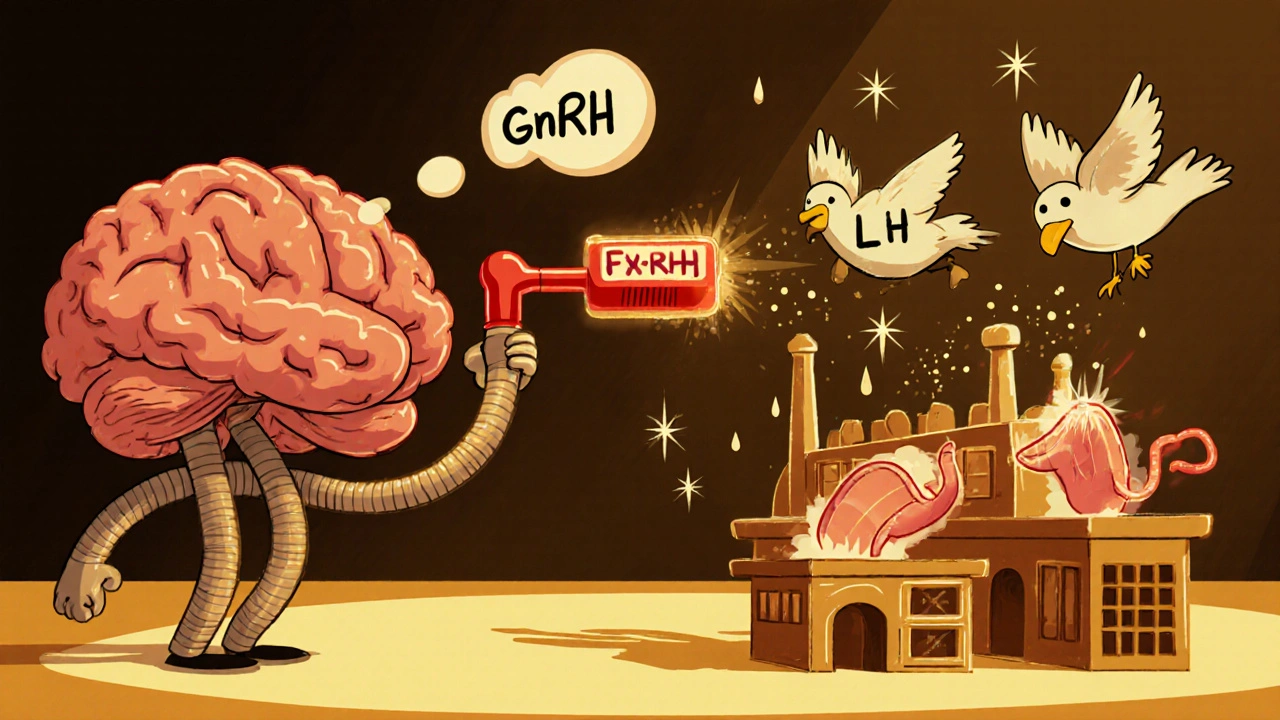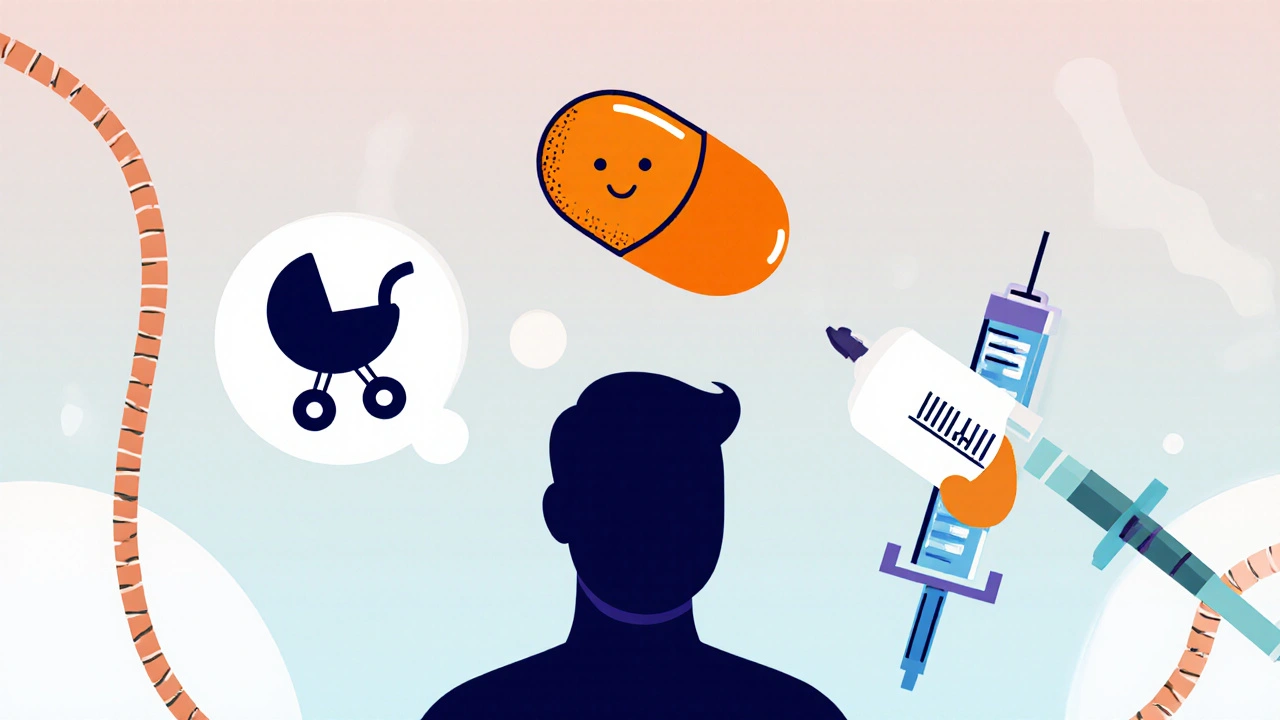Hypogonadism Treatment Selector
Find Your Best Option
Answer a few questions to identify which testosterone management approach aligns with your priorities.
Other Options to Consider
Quick Takeaways
- Androxal is a selective estrogen receptor modulator (SERM) that raises natural testosterone without adding external hormone.
- Clomiphene citrate works similarly but includes both enclomiphene and zuclomiphene isomers, which can cause more side‑effects.
- hCG therapy mimics luteinising hormone, boosting testosterone production but requires injections.
- Testosterone Replacement Therapy (TRT) supplies pre‑formed hormone; it’s effective but suppresses the body’s own production.
- Choosing the right option depends on age, fertility goals, side‑effect tolerance, and whether you need a prescription.
Androxal is a brand‑name formulation of enclomiphene, a selective estrogen receptor modulator (SERM) developed to stimulate the body’s own testosterone production while preserving fertility. Approved in Canada and several European markets, it offers a prescription‑only alternative to traditional testosterone replacement.
What is Androxal (Enclomiphene)?
Enclomiphene is the trans‑isomer of clomiphene. Unlike its counterpart zuclomiphene, enclomiphene has a shorter half‑life and a cleaner side‑effect profile. It binds to estrogen receptors in the hypothalamus, tricking the brain into thinking estrogen levels are low. This triggers the release of gonadotropin‑releasing hormone (GnRH), which in turn prompts the pituitary to secrete luteinising hormone (LH) and follicle‑stimulating hormone (FSH). The rise in LH stimulates Leydig cells in the testes to produce more testosterone.
How does Androxal differ from other SERMs?
All SERMs share the core mechanism of blocking estrogen feedback, but they vary in chemical composition, dosage, and ancillary effects. The table below contrasts Androxal with the most common alternatives.
| Agent | Mechanism | Typical Dose | Regulatory Status (2025) | Primary Use Cases | Pros | Cons |
|---|---|---|---|---|---|---|
| Androxal (Enclomiphene) | Selective estrogen receptor antagonism (testosterone‑stimulating) | 12.5-25 mg daily | Approved in Canada, UK (via specialist), EU (limited) | Low‑to‑moderate hypogonadism, fertility preservation | Oral, maintains intratesticular testosterone, minimal estrogenic side‑effects | Prescription only, not FDA‑approved in US, higher cost than generic clomiphene |
| Clomiphene citrate | Mixed SERM (both enclomiphene & zuclomiphene isomers) | 25-50 mg daily | FDA‑approved for female infertility; off‑label for men | Male hypogonadism, ovulation induction | Cheap, widely available | Higher risk of visual disturbances, mood swings, gynecomastia due to zuclomiphene |
| Tamoxifen | Estrogen receptor antagonist in breast tissue, partial agonist elsewhere | 10-20 mg daily | FDA‑approved for breast cancer; off‑label for men | Gynecomastia treatment, aromatase‑related testosterone decline | Reduces estrogen‑driven side‑effects, oral | Thrombo‑embolic risk, hot flashes, limited testosterone boost |
| Aromatase inhibitors (e.g., Anastrozole) | Blocks conversion of testosterone to estradiol | 0.5-1 mg daily | FDA‑approved for breast cancer; off‑label for men | Men with high estrogen, bodybuilding, TRT adjunct | Rapid estradiol reduction, can raise total testosterone | Potential bone density loss, joint pain, may suppress LH/FSH long‑term |
| hCG therapy | Mimics LH, directly stimulates Leydig cells | 500-2000 IU 2-3×/week (injection) | Off‑label; FDA‑approved for female infertility | Post‑TRT recovery, fertility preservation | Boosts intratesticular testosterone, preserves sperm | Requires injections, risk of gynecomastia if estrogen spikes |
| Testosterone Replacement Therapy (TRT) | Direct supplementation of exogenous testosterone | 50-200 mg weekly (injection) or gel/patch daily | FDA‑approved worldwide | Clinical hypogonadism, severe symptoms | Predictable serum levels, rapid symptom relief | Suppresses endogenous production, may reduce fertility, requires monitoring |

When to Choose Androxal Over Alternatives
- Fertility matters. Because enclomiphene preserves intratesticular testosterone, sperm counts remain stable, unlike TRT which often shuts down spermatogenesis.
- You prefer an oral option and want to avoid injections.
- Your estrogen levels are within normal range, so an aromatase inhibitor would add unnecessary complexity.
- You have experienced visual disturbances or mood swings on clomiphene; Androxal’s purified isomer reduces those risks.
Potential Side‑Effects and Safety Profile
Clinical trials (e.g., 2023 Phase III study by the University of Toronto) reported the most common adverse events for Androxal as mild headache, transient nausea, and occasional hot flashes. Serious events such as thrombo‑embolism were <1% and comparable to placebo.
In contrast, clomiphene’s mixed isomer composition accounts for a higher incidence of visual disturbances (≈5%) and mood fluctuations (≈7%). Tamoxifen brings a modest clot risk, especially in smokers over 45. Aromatase inhibitors can affect bone health, requiring calcium/vitamin D supplementation. hCG injections sometimes cause gynecomastia if estrogen spikes aren’t managed.
Practical Checklist Before Starting Therapy
- Get baseline labs: total testosterone, free testosterone, LH, FSH, estradiol, CBC, liver panel.
- Discuss fertility goals with a specialist; if you plan to father children, Androxal or hCG are preferred.
- Review medication history for contraindications: clotting disorders (tamoxifen), liver disease (SERMs), bone loss (aromatase inhibitors).
- Confirm insurance coverage or out‑of‑pocket cost; Androxal can be pricier than generic clomiphene.
- Set a follow‑up schedule: repeat labs in 6-8 weeks, then every 3-6 months.
Cost Comparison (2025 US $)
- Androxal: $120-$150 per month (depends on pharmacy).
- Clomiphene citrate (generic): $30-$50 per month.
- Tamoxifen: $45-$70 per month.
- Aromatase inhibitors: $50-$80 per month.
- hCG injections: $80-$120 per month (drug plus syringes).
- TRT (injectable): $130-$170 per month (excluding labs).
Bottom Line: Which Option Wins?
If you’re a man in his 30s‑40s, want to boost energy and libido without compromising future fertility, Androxal stands out as the most balanced oral SERM. For men who need a cheap, widely available solution and can tolerate occasional visual side‑effects, clomiphene remains a viable off‑label choice. When estrogen dominates the picture (e.g., aromatase‑driven gynecomastia), an aromatase inhibitor or tamoxifen may be added. For severe hypogonadism where rapid symptom relief is essential, TRT is still the gold standard, but it comes with the trade‑off of suppressed sperm production.
Frequently Asked Questions
Is Androxal legal in the United States?
As of 2025, Androxal has not received FDA approval. It can be imported for personal use under a physician’s supervision, but it is not legally marketed in the US.
How fast can I expect testosterone levels to rise?
Most men see a 30‑50% increase in total testosterone within 8‑12 weeks of a consistent 12.5 mg daily dose.
Can I combine Androxal with an aromatase inhibitor?
Yes, if estradiol climbs above the normal range. A low dose of anastrozole (0.5 mg) is often used, but always under doctor supervision to avoid excessive estrogen suppression.
Will Androxal affect my cholesterol?
Studies show neutral to modestly improved lipid profiles, likely because testosterone itself has a favorable effect on HDL and LDL.
What monitoring is required while on Androxal?
Baseline labs, then repeat testosterone, estradiol, LH/FSH at 6‑8 weeks, followed by checks every 3‑6 months. Also watch for visual changes or mood swings.
 Oct, 7 2025
Oct, 7 2025

Michael Kusold
October 7, 2025 AT 07:00The table's layout is pretty clear, but it would be nice to see a column for cost comparison. Also, some of the dosage units could use a bit more consistency.
Jeremy Lysinger
October 15, 2025 AT 20:21Great rundown! I love how each option’s pros and cons are laid out side by side.
Nelson De Pena
October 24, 2025 AT 09:42This guide hits the mark for guys looking to keep fertility while boosting testosterone. The distinction between enclomiphene and the mixed isomers is spot on. Definitely a useful read for anyone weighing oral SERMs against injections.
Wilson Roberto
November 1, 2025 AT 23:03When considering androgenic optimization, one must weigh not only the biochemical pathways but also the broader physiological context. Enclomiphene's selective estrogen receptor antagonism allows the hypothalamic-pituitary-gonadal axis to remain engaged, preserving intratesticular testosterone crucial for spermatogenesis. In contrast, exogenous testosterone replacement imposes a negative feedback loop, often leading to gonadal atrophy and diminished sperm output. For patients whose reproductive goals intersect with performance goals, this distinction becomes a pivotal decision node.
Moreover, the pharmacokinetic profile of enclomiphene-characterized by a relatively short half‑life compared to its counterpart zuclomiphene-translates to a steadier hormonal milieu with fewer peaks and troughs. This steadiness mitigates the risk of mood swings and visual disturbances frequently reported with traditional clomiphene usage. The oral route also circumvents the needle aversion many men experience, improving adherence.
However, the cost factor cannot be ignored. Androxal carries a premium price tag, especially in markets where it lacks generic competition. While the therapeutic benefits may justify the expense for some, others might find the cheaper off‑label clomiphene a more pragmatic choice, accepting the trade‑off of a slightly less favorable side‑effect profile.
From a clinical monitoring standpoint, patients on enclomiphene should still undergo periodic assessments of estradiol, LH, and FSH levels to ensure the axis remains balanced. In cases where estradiol begins to rise, adjunctive aromatase inhibition may become necessary to prevent gynecomastia.
In summary, enclomiphene presents a compelling blend of efficacy, fertility preservation, and oral convenience, making it an attractive option for a specific subset of hypogonadal men. Its limitations lie primarily in availability and cost, factors that must be weighed against individual patient priorities.
Narasimha Murthy
November 10, 2025 AT 12:24The analysis is thorough, yet it glosses over the economic reality for most patients. While Androxal’s pharmacology is commendable, its limited approval and premium pricing render it impractical for widespread use. A more balanced discussion would incorporate real‑world accessibility concerns.
Samantha Vondrum
November 19, 2025 AT 01:45Thank you for this comprehensive overview; it will certainly aid many individuals in making informed decisions. 🌟 Please remember that personal medical advice should always be sought from a qualified healthcare professional. 😊